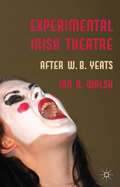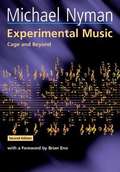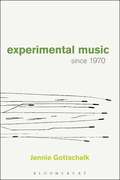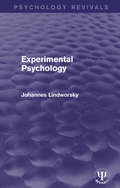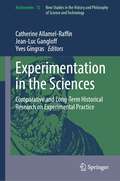- Table View
- List View
Experimental Film and Queer Materiality
by Juan A. Su?rezOften described as an art of abstraction and subjective introspection, experimental film is also invested in exploring daily objects and materials and in channeling, in the process, a peculiar perception of the modern everyday that this book calls queer materiality. Queer materiality designates the queer latency of modern material culture, which often inspired queer artists and filmmakers to envision wayward bodies and behaviors, and refers to the way in which sexual and social dissidence was embedded in the objects, technologies, substances, and spaces that make up the hardware of experience. This book studies a rich archive of queer material engagements in work by well-known filmmakers such as Andy Warhol, Barbara Hammer, Carolee Schneemann, and Jack Smith as well as under-recognized figures such as Tom Chomont, Jim Hubbard, Ashley Hans Scheirl, and Teo Hern?ndez. Combining history, formal analysis, and theoretical reflection, author Juan A. Su?rez shows how plastics, glitter, mechanical ensembles, urban ruins, garbage, amphetamine, film grain, and noise have been mobilized in the articulation of queerness for the screen. Experimental Film and Queer Materiality is an inquiry into the liveliness of matter and into the interface between sexuality and the material world.
The Experimental Fire: Inventing English Alchemy, 1300-1700 (Synthesis)
by Jennifer M. RamplingIn medieval and early modern Europe, the practice of alchemy promised extraordinary physical transformations. Who would not be amazed to see base metals turned into silver and gold, hard iron into soft water, and deadly poison into elixirs that could heal the human body? To defend such claims, alchemists turned to the past, scouring ancient books for evidence of a lost alchemical heritage and seeking to translate their secret language and obscure imagery into replicable, practical effects. Tracing the development of alchemy in England over four hundred years, from the beginning of the fourteenth century to the end of the seventeenth, Jennifer M. Rampling illuminates the role of alchemical reading and experimental practice in the broader context of national and scientific history. Using new manuscript sources, she shows how practitioners like George Ripley, John Dee, and Edward Kelley, as well as many previously unknown alchemists, devised new practical approaches to alchemy while seeking the support of English monarchs. By reconstructing their alchemical ideas, practices, and disputes, Rampling reveals how English alchemy was continually reinvented over the space of four centuries, resulting in changes to the science itself. In so doing, The Experimental Fire bridges the intellectual history of chemistry and the wider worlds of early modern patronage, medicine, and science.
Experimental Histories: Interpolation and the Medieval British Past
by Hannah WeaverIn Experimental Histories, Hannah Weaver examines the medieval practice of interpolation—inserting material from one text into another—which is often categorized as being a problematic, inauthentic phenomenon akin to forgery and pseudepigraphy. Instead, Weaver promotes interpolation as the signature form of medieval British historiography and a vehicle of historical theory, arguing that some of the most novel concepts of time in medieval historiography can be found in these altered narratives of the past.For Weaver, historiographical interpolation constitutes the traces of active experimentation with how best to write history, particularly the history of Britain. Historians in twelfth- and thirteenth-century Britain recognized the difficulty of enfolding complex events into a linear chronology and embraced innovative textual methods of creating history. Focusing on the Brut tradition but also analyzing the long history of interpolated historiography, including the Bayeux Embroidery, Experimental Histories offers a new interpretation of generic remixing in medieval writing about the past. Drawing on both manuscript studies and the new formalism, it shows that the practice of inserting materials from romance and hagiography allowed creative revisers to explore how lived events relate to passing time. By embracing interpolation, Weaver provides lively insights into the ways that time becomes history and human actors experience time.
Experimental Inquiries: Historical, Philosophical and Social Studies of Experimentation in Science (Studies in History and Philosophy of Science #8)
by H. E. GrandThe institutionalization of History and Philosophy of Science as a distinct field of scholarly endeavour began comparatively early -- though not always under that name -- in the Australasian region. An initial lecturing appointment was made at the University of Melbourne imme diately after the Second World War, in 1946, and other appointments followed as the subject underwent an expansion during the 1950s and 1960s similar to that which took place in other parts of the world. Today there are major Departments at the University of Melbourne, the University of New South Wales and the University of Wollongong, and smaller groups active in many other parts of Australia and in New Zealand. 'Australasian Studies in History and Philosophy of Science' aims to provide a distinctive publication outlet for Australian and New Zealand scholars working in the general area of history, philosophy and social studies of science. Each volume comprises a group of essays on a connected theme, edited by an Australian or a New Zealander with special expertise in that particular area. Papers address general issues, however, rather than local ones; parochial topics are avoided. Further more, though in each volume a majority of the contributors is from Australia or New Zealand, contributions from elsewhere are by no means ruled out. Quite the reverse, in fact -- they are actively encour aged wherever appropriate to the balance of the volume in question.
Experimental Irish Theatre: After W.B. Yeats
by I. WalshThis book examines experimental Irish theatre that ran counter to the naturalistic 'peasant' drama synonymous with Irish playwriting. Focusing on four marginalised playwrights after Yeats, it charts a tradition linking the experimentation of the early Irish theatre movement with the innovation of contemporary Irish and international drama.
Experimental Legislation in China between Efficiency and Legality: The Delegated Legislative Power of the Shenzhen Special Economic Zone
by Madeleine MartinekThis book analyzes the benefits of and legal concerns in connection with the delegated legislation of the Shenzhen Special Economic Zone as a prime example of experimental legislation in Chinese law. It offers solutions for improving the legal design of experimental regulations in Special Economic Zones by striking a balance between the pursuit of rapid socio-economic progress on the one hand, and the increasing need and will to govern by the rule of law on the other. The book offers a valuable guide for the academic community and legal practitioners, as well as students eager to gain insights into Chinese constitutional law and the conflict between legality and achieving reforms.
Experimental Life: Vitalism in Romantic Science and Literature
by Robert MitchellIf the objective of the Romantic movement was nothing less than to redefine the meaning of life itself, what role did experiments play in this movement? While earlier scholarship has established both the importance of science generally and vitalism specifically, with regard to Romanticism no study has investigated what it meant for artists to experiment and how those experiments related to their interest in the concept of life.Experimental Life draws on approaches and ideas from contemporary science studies, proposing the concept of experimental vitalism to show both how Romantic authors appropriated the concept of experimentation from the sciences and the impact of their appropriation on post-Romantic concepts of literature and art.Robert Mitchell navigates complex conceptual arenas such as network theory, gift exchange, paranoia, and biomedia and introduces new concepts, such as cryptogamia, chylopoietic discourse, trance-plantation, and the poetics of suspension. As a result, Experimental Life is a wide-ranging summation and extension of the current state of literary studies, the history of science, cultural critique, and theory.
Experimental Life: Vitalism in Romantic Science and Literature
by Robert MitchellIf the objective of the Romantic movement was nothing less than to redefine the meaning of life itself, what role did experiments play in this movement? While earlier scholarship has established both the importance of science generally and vitalism specifically, with regard to Romanticism no study has investigated what it meant for artists to experiment and how those experiments related to their interest in the concept of life.Experimental Life draws on approaches and ideas from contemporary science studies, proposing the concept of experimental vitalism to show both how Romantic authors appropriated the concept of experimentation from the sciences and the impact of their appropriation on post-Romantic concepts of literature and art.Robert Mitchell navigates complex conceptual arenas such as network theory, gift exchange, paranoia, and biomedia and introduces new concepts, such as cryptogamia, chylopoietic discourse, trance-plantation, and the poetics of suspension. As a result, Experimental Life is a wide-ranging summation and extension of the current state of literary studies, the history of science, cultural critique, and theory.
Experimental Medicine
by Claude Bernard Stewart WolfThe French physiologist Claude Bernard was responisble for investigating the chemical phenomena of digestion. This text reproduces his research into experimental medicine. A new introduction looks at his impact on the world of medicine.
Experimental Medicine (Dover Books On Biology Ser.)
by Claude Bernard Stewart WolfThe French physiologist Claude Bernard was responisble for investigating the chemical phenomena of digestion. This text reproduces his research into experimental medicine. A new introduction looks at his impact on the world of medicine.
Experimental Music: Cage and Beyond (PDF)
by Michael Nyman Foreword by Brian EnoMichael Nyman's book is a first-hand account of experimental music from 1950 to 1970. First published in 1974, it has remained the classic text on a significant form of music making and composing which developed alongside, and partly in opposition to, the post-war modernist tradition of composers such as Boulez, Berio, or Stockhausen. The experimentalist par excellence was John Cage whose legendary 4' 33'' consists of four minutes and thirty three seconds of silence to be performed on any instrument. Such pieces have a conceptual rather than purely musical starting point and radically challenge conventional notions of the musical work. Nyman's book traces the revolutionary attitudes that were developed towards concepts of time, space, sound, and composer/performer responsibility. It was within the experimental tradition that the seeds of musical minimalism were sown and the book contains reference to the early works of Reich, Riley, Young, and Glass.
Experimental Music Since 1970
by Jennie GottschalkWhat is experimental music today? This book offers an up to date survey of this field for anyone with an interest, from seasoned practitioners to curious readers. This book takes the stance that experimental music is not a limited historical event, but is a proliferation of approaches to sound that reveals much about present-day experience. An experimental work is not identifiable by its sound alone, but by the nature of the questions it poses and its openness to the sounding event.Experimentation is a way of working. It pushes past that which is known to discover what lies beyond it, finding new knowledge, forms, and relationships, or accepting a state of uncertainty. For each of these composers and sound artists, craft is developed and transformed in response to the questions they bring to their work. Scientific, perceptual, or social phenomena become catalysts in the operation of the work. These practices are not presented according to a chronology, a set of techniques, or social groupings. Instead, they are organized according to the content areas that are their subjects, including resonance, harmony, objects, shapes, perception, language, interaction, sites, and histories. Musical materials may be subject, among other treatments, to systemization, observation, examination, magnification, fragmentation, translation, or destabilization. These restless and exploratory modes of engagement have continued to develop over recent decades, expanding the scope of both musical practice and listening.
Experimental Music Since 1970
by Jennie GottschalkWhat is experimental music today? This book offers an up to date survey of this field for anyone with an interest, from seasoned practitioners to curious readers. This book takes the stance that experimental music is not a limited historical event, but is a proliferation of approaches to sound that reveals much about present-day experience. An experimental work is not identifiable by its sound alone, but by the nature of the questions it poses and its openness to the sounding event.Experimentation is a way of working. It pushes past that which is known to discover what lies beyond it, finding new knowledge, forms, and relationships, or accepting a state of uncertainty. For each of these composers and sound artists, craft is developed and transformed in response to the questions they bring to their work. Scientific, perceptual, or social phenomena become catalysts in the operation of the work. These practices are not presented according to a chronology, a set of techniques, or social groupings. Instead, they are organized according to the content areas that are their subjects, including resonance, harmony, objects, shapes, perception, language, interaction, sites, and histories. Musical materials may be subject, among other treatments, to systemization, observation, examination, magnification, fragmentation, translation, or destabilization. These restless and exploratory modes of engagement have continued to develop over recent decades, expanding the scope of both musical practice and listening.
Experimental Philosophy and the Birth of Empirical Science: Boyle, Locke and Newton
by Michael Ben-ChaimHow did empirical research become the cornerstone of modern science? Scholars have traditionally associated empirical research with the search for knowledge, but have failed to provide adequate solutions to this basic historical problem. This book offers a different approach that focuses on human understanding - rather than knowledge - and its cultural expression in the creation and social transaction of causal explanations. Ancient Greek philosophers professed that genuine understanding of a particular subject was gained only when its nature, or essence, was defined. This ancient mode of explanation furnished the core teachings of late medieval natural philosophers, and was reaffirmed by early modern philosophers such as Bacon and Descartes. Yet during the second half of the 17th century, radical transformation gave rise to innovative research practices that were designed to explain how empirical properties of the physical world were correlated. The study unfolded in this book centres on the works of Robert Boyle, John Locke, and Isaac Newton - the most notable exponents of the 'experimental philosophy' in the late 17th century - to explore how this transformation led to the emergence of a recognizably modern culture of empirical research. Relating empirical with explanatory practices, this book offers a novel solution to one of the major problems in the history of western science and philosophy. It thereby provides a new perspective on the Scientific Revolution and the origins of modern empiricism. At the same time, this book demonstrates how historical and sociological tools can be combined to study science as an evolving institution of human understanding.
Experimental Philosophy and the Birth of Empirical Science: Boyle, Locke and Newton
by Michael Ben-ChaimHow did empirical research become the cornerstone of modern science? Scholars have traditionally associated empirical research with the search for knowledge, but have failed to provide adequate solutions to this basic historical problem. This book offers a different approach that focuses on human understanding - rather than knowledge - and its cultural expression in the creation and social transaction of causal explanations. Ancient Greek philosophers professed that genuine understanding of a particular subject was gained only when its nature, or essence, was defined. This ancient mode of explanation furnished the core teachings of late medieval natural philosophers, and was reaffirmed by early modern philosophers such as Bacon and Descartes. Yet during the second half of the 17th century, radical transformation gave rise to innovative research practices that were designed to explain how empirical properties of the physical world were correlated. The study unfolded in this book centres on the works of Robert Boyle, John Locke, and Isaac Newton - the most notable exponents of the 'experimental philosophy' in the late 17th century - to explore how this transformation led to the emergence of a recognizably modern culture of empirical research. Relating empirical with explanatory practices, this book offers a novel solution to one of the major problems in the history of western science and philosophy. It thereby provides a new perspective on the Scientific Revolution and the origins of modern empiricism. At the same time, this book demonstrates how historical and sociological tools can be combined to study science as an evolving institution of human understanding.
Experimental Psychology: Ambitions and Possibilities (Theory and History in the Human and Social Sciences)
by Davood Gozli Jaan ValsinerThis work brings together different perspectives on psychological methods and particularly methods involving experimentation. To encourage a reflective use of research methods, the authors illuminate the historical, philosophical, and scientific dimensions of methodology, providing both defenses and criticisms of experimental psychology. The primary audience of the work are students and researchers in psychological and behavioral sciences, who have an interest in methodology
Experimental Psychology (Psychology Revivals)
by Johannes LindworskyOriginally published in German in 1923, this English edition was first published in 1931. From the translators preface: "Experimentelle Psychologie is characterized by an excellent summarizing of the most recent experimental data and by a spirit of fairness which it exhibits in organizing facts under general theoretical principles. Besides informing the reader, it stimulates him by critical remarks and suggestions for further thinking and experimentation." Today it can be read and enjoyed in its historical context.
Experimental Psychology (Psychology Revivals)
by Johannes LindworskyOriginally published in German in 1923, this English edition was first published in 1931. From the translators preface: "Experimentelle Psychologie is characterized by an excellent summarizing of the most recent experimental data and by a spirit of fairness which it exhibits in organizing facts under general theoretical principles. Besides informing the reader, it stimulates him by critical remarks and suggestions for further thinking and experimentation." Today it can be read and enjoyed in its historical context.
The Experimental Psychology of Beauty: The Experimental Psychology Of Beauty (Collected Works of C.W. Valentine)
by C.W. ValentineOriginally published in 1962, the experimental study of aesthetics was a field particularly associated with the name of C.W. Valentine, who in this book provided a critical review of research carried out since the end of the nineteenth century principally by British and American psychologists. The investigations described, many of them conducted by the author, are concerned with individual responses to what is commonly regarded as beautiful in painting, music, and poetry, an important distinction being made between the perception of objects as ‘beautiful’ as opposed to ‘pleasing’. The reactions of children and adults, and of people having different ethnic and social backgrounds, are explored in a variety of experiments dealing with specific elements, including colour, form, and balance in painting; musical intervals, discord, harmony, melody, and tempo; and rhythm, metre, imagery, and associations in classical and romantic poetry. Other experiments seek to disclose the temperamental and attitudinal factors underlying individual differences in the judgement and appreciation of specific works of art. Of particular interest are the studies of responses to modern paintings, poems and musical compositions. The findings throw light on the development of discrimination and taste and suggest the possibility of some common factor in the appreciation of these three arts. It was felt that critics as well as psychologists and aestheticians would find much to encourage reflection and to stimulate further research.
The Experimental Psychology of Beauty (Collected Works of C.W. Valentine)
by C.W. ValentineOriginally published in 1962, the experimental study of aesthetics was a field particularly associated with the name of C.W. Valentine, who in this book provided a critical review of research carried out since the end of the nineteenth century principally by British and American psychologists. The investigations described, many of them conducted by the author, are concerned with individual responses to what is commonly regarded as beautiful in painting, music, and poetry, an important distinction being made between the perception of objects as ‘beautiful’ as opposed to ‘pleasing’. The reactions of children and adults, and of people having different ethnic and social backgrounds, are explored in a variety of experiments dealing with specific elements, including colour, form, and balance in painting; musical intervals, discord, harmony, melody, and tempo; and rhythm, metre, imagery, and associations in classical and romantic poetry. Other experiments seek to disclose the temperamental and attitudinal factors underlying individual differences in the judgement and appreciation of specific works of art. Of particular interest are the studies of responses to modern paintings, poems and musical compositions. The findings throw light on the development of discrimination and taste and suggest the possibility of some common factor in the appreciation of these three arts. It was felt that critics as well as psychologists and aestheticians would find much to encourage reflection and to stimulate further research.
The Experimental Self: Humphry Davy and the Making of a Man of Science (Synthesis)
by Jan GolinskiWhat did it mean to be a scientist before the profession itself existed? Jan Golinski finds an answer in the remarkable career of Humphry Davy, the foremost chemist of his day and one of the most distinguished British men of science of the nineteenth century. Originally a country boy from a modest background, Davy was propelled by his scientific accomplishments to a knighthood and the presidency of the Royal Society. An enigmatic figure to his contemporaries, Davy has continued to elude the efforts of biographers to classify him: poet, friend to Coleridge and Wordsworth, author of travel narratives and a book on fishing, chemist and inventor of the miners’ safety lamp. What are we to make of such a man? In The Experimental Self, Golinski argues that Davy’s life is best understood as a prolonged process of self-experimentation. He follows Davy from his youthful enthusiasm for physiological experiment through his self-fashioning as a man of science in a period when the path to a scientific career was not as well-trodden as it is today. What emerges is a portrait of Davy as a creative fashioner of his own identity through a lifelong series of experiments in selfhood.
The Experimental Self: Humphry Davy and the Making of a Man of Science (Synthesis)
by Jan GolinskiWhat did it mean to be a scientist before the profession itself existed? Jan Golinski finds an answer in the remarkable career of Humphry Davy, the foremost chemist of his day and one of the most distinguished British men of science of the nineteenth century. Originally a country boy from a modest background, Davy was propelled by his scientific accomplishments to a knighthood and the presidency of the Royal Society. An enigmatic figure to his contemporaries, Davy has continued to elude the efforts of biographers to classify him: poet, friend to Coleridge and Wordsworth, author of travel narratives and a book on fishing, chemist and inventor of the miners’ safety lamp. What are we to make of such a man? In The Experimental Self, Golinski argues that Davy’s life is best understood as a prolonged process of self-experimentation. He follows Davy from his youthful enthusiasm for physiological experiment through his self-fashioning as a man of science in a period when the path to a scientific career was not as well-trodden as it is today. What emerges is a portrait of Davy as a creative fashioner of his own identity through a lifelong series of experiments in selfhood.
The Experimental Self: Humphry Davy and the Making of a Man of Science (Synthesis)
by Jan GolinskiWhat did it mean to be a scientist before the profession itself existed? Jan Golinski finds an answer in the remarkable career of Humphry Davy, the foremost chemist of his day and one of the most distinguished British men of science of the nineteenth century. Originally a country boy from a modest background, Davy was propelled by his scientific accomplishments to a knighthood and the presidency of the Royal Society. An enigmatic figure to his contemporaries, Davy has continued to elude the efforts of biographers to classify him: poet, friend to Coleridge and Wordsworth, author of travel narratives and a book on fishing, chemist and inventor of the miners’ safety lamp. What are we to make of such a man? In The Experimental Self, Golinski argues that Davy’s life is best understood as a prolonged process of self-experimentation. He follows Davy from his youthful enthusiasm for physiological experiment through his self-fashioning as a man of science in a period when the path to a scientific career was not as well-trodden as it is today. What emerges is a portrait of Davy as a creative fashioner of his own identity through a lifelong series of experiments in selfhood.
The Experimental Self: Humphry Davy and the Making of a Man of Science (Synthesis)
by Jan GolinskiWhat did it mean to be a scientist before the profession itself existed? Jan Golinski finds an answer in the remarkable career of Humphry Davy, the foremost chemist of his day and one of the most distinguished British men of science of the nineteenth century. Originally a country boy from a modest background, Davy was propelled by his scientific accomplishments to a knighthood and the presidency of the Royal Society. An enigmatic figure to his contemporaries, Davy has continued to elude the efforts of biographers to classify him: poet, friend to Coleridge and Wordsworth, author of travel narratives and a book on fishing, chemist and inventor of the miners’ safety lamp. What are we to make of such a man? In The Experimental Self, Golinski argues that Davy’s life is best understood as a prolonged process of self-experimentation. He follows Davy from his youthful enthusiasm for physiological experiment through his self-fashioning as a man of science in a period when the path to a scientific career was not as well-trodden as it is today. What emerges is a portrait of Davy as a creative fashioner of his own identity through a lifelong series of experiments in selfhood.
Experimentation in the Sciences: Comparative and Long-Term Historical Research on Experimental Practice (Archimedes #72)
by Yves Gingras Catherine Allamel-Raffin Jean-Luc GangloffThis book takes a novel approach by highlighting comparative and long-term historical perspectives on experimental practice. The juxtaposition of accounts of natural, social, and medical experimentation is very enlightening, especially because the authors put the emphasis on the different kinds of objects of experimentation (physical matter, chemical reagents, social groups, organizations, sick individuals, archeological remains) and demonstrate how much the kinds of objects matter for the practice of experimentation, its methods, tools, and methodologies. Taken together, the chapters raise several fascinating questions for further study: What do these different approaches have in common? Why do we call them “experimentation”? What are the intersections among the fields and their developments? The volume engages philosophical approaches that are not well known to Anglophone readers (Bachelard, Bergson, Bernard, Canguilhem, among others) and brings to attention a wealth of Francophone secondary literature on past and present scientific experimentation. The collection fills a yawning gap in science, science studies, and philosophy of science teaching, making it particularly valuable philosophers and historians of science in all subfields.




